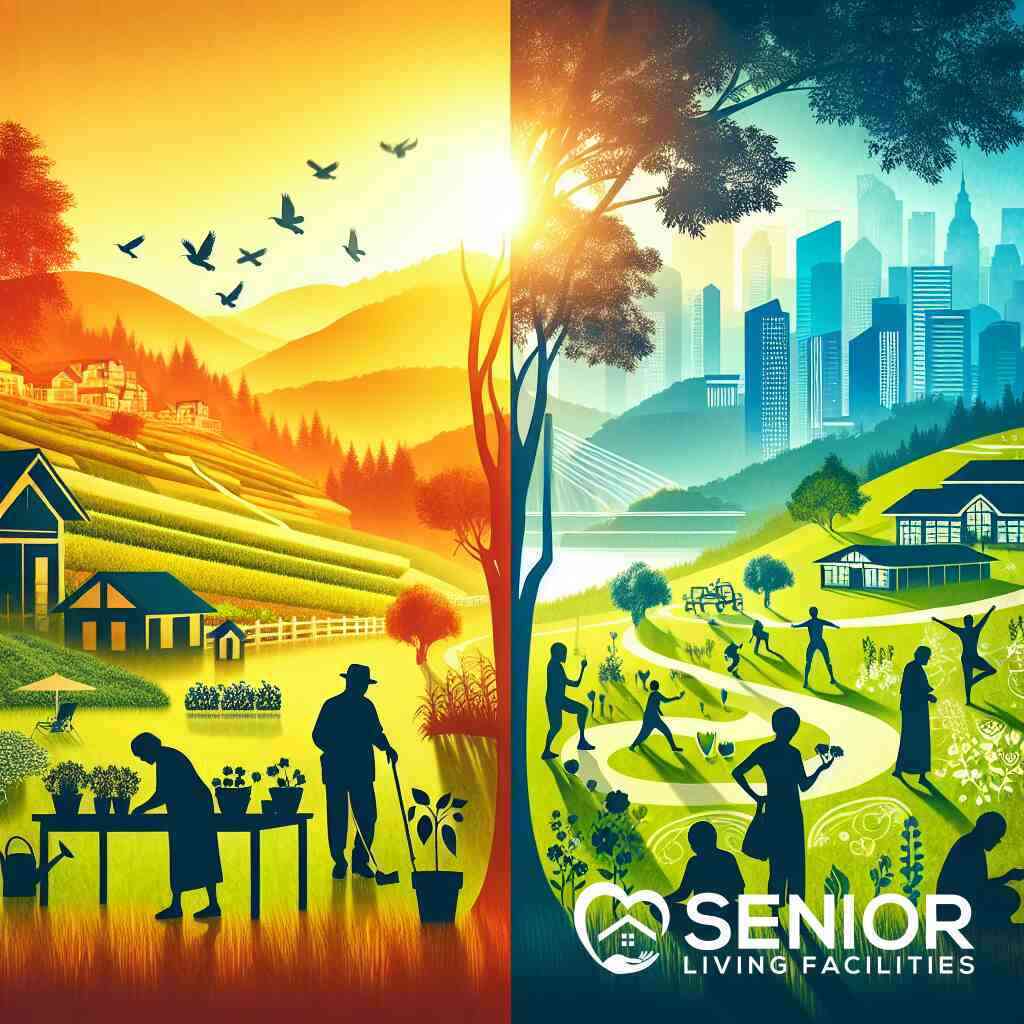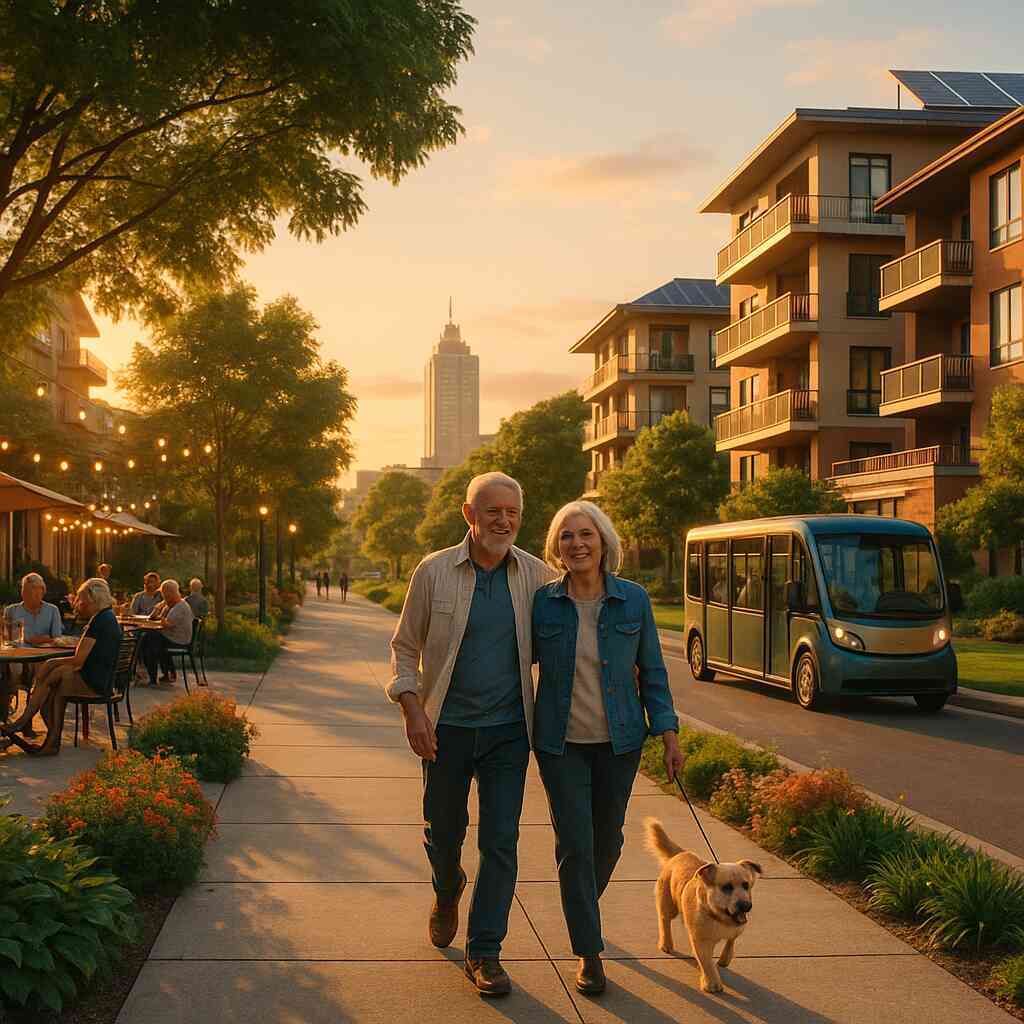
Comparing Urban vs Rural Senior Living Facilities
October 4, 2024
Exploring the Landscape of Senior Living Options
Understanding Urban and Rural Senior Living Facilities
Senior living facilities are designed to cater to the diverse needs of older adults, offering various amenities and services tailored to enhance their quality of life. Urban senior living facilities frequently provide more technologically advanced solutions and opportunities for social engagement, thanks to their location in bustling city environments. In contrast, rural senior living facilities often emphasize tranquility and proximity to nature, offering a serene atmosphere crucial for some seniors’ well-being. Understanding these differences can help families make well-informed decisions about the location and type of senior living that best suits their needs. Senior living communities often need to strike a balance between their offerings, amenities, and the unique environment surrounding them, whether urban or rural.
Key Factors When Choosing a Senior Living Facility
When selecting the ideal senior living facility, several factors come into play, including location, cost, level of medical care, and available recreational activities. Urban areas often boast a wide array of amenities and healthcare options within proximity, but they may come at a premium price. Conversely, rural facilities may offer a more budget-friendly option while providing a peaceful atmosphere that many seniors cherish. Families should also consider transportation options, security, and the proximity of family and friends. Ultimately, the goal is to find a senior living facility that aligns with personal values and health requirements, ensuring the best possible environment for seniors. Additionally, families can refer to resources like online platforms that provide insights into local senior living facilities.
Evaluating Personal Needs and Preferences
Determining personal needs and preferences is crucial when evaluating senior living facilities. Some seniors prefer the hustle and bustle of an urban environment, enjoying easy access to cultural events, restaurants, and social activities. Others might value the quiet and wide-open spaces offered by rural living. Medical needs, lifestyle choices, and social connections all play significant roles in these preferences. By conducting thorough research and possibly consulting with senior living advisors, families can better match their loved ones with a suitable facility. It’s important to remember that the best choice for a senior living environment prioritizes the emotional, social, and physical health of the individual residing there.
Urban Senior Living Facilities
Characteristics of Urban Senior Living Communities
Urban senior living communities are known for their dynamic environments that meld modern conveniences with a rich tapestry of cultural experiences. These facilities are often strategically located near bustling city centers, offering seniors quick access to a plethora of amenities. From state-of-the-art healthcare facilities to cultural landmarks, urban senior living facilities cater to those who desire proximity to diverse activities and services. Features of urban senior living communities often include robust public transportation links, allowing residents to engage in the city’s offerings easily. For seniors who are tech-savvy or wish to remain active in cultural pursuits, these communities provide ample opportunities for engagement and enrichment.
Seniors living in urban settings benefit from an environment that encourages continual learning and social interaction. These communities frequently host educational seminars, art classes, and leisure activities designed to keep residents mentally and physically stimulated. Urban senior housing often includes features like fitness centers, libraries, and communal spaces dedicated to crafting events or discussions and and enhancing community bonds. Moreover, the architecture of urban facilities often combines contemporary design with accessibility, ensuring comfort while navigating the city landscape. Exploring features of urban senior living can reveal how these communities set the stage for vibrant, connected lifestyles.
Advantages of City Senior Housing
One key advantage of city senior housing is exceptional access to medical care and specialized services. Urban areas offer a wealth of healthcare options, including top-tier hospitals, specialist clinics, and rehabilitation centers, often located conveniently within or near senior facilities. Residents benefit from the availability of advanced medical treatments and emergency services, promoting peace of mind for both seniors and their families.
Urban senior communities also offer a variety of entertainment and dining options that cater to diverse tastes and preferences. From theaters and museums to eclectic restaurants and cafes, the cultural life in cities provides endless opportunities for outings and socialization. This vibrant urban experience fosters a stimulating environment that many seniors find invigorating. Additionally, city housing often allows for a seamless integration into existing urban life, enabling seniors to participate in community events and maintain social ties, thereby enhancing overall well-being.
Challenges Faced by Urban Elder Care
Despite the numerous benefits, urban elder care does come with its own set of challenges. The fast-paced nature of city life can be overwhelming for some seniors, particularly those who prefer quieter settings. Noise pollution, higher cost of living, and crowded environments can be significant drawbacks, affecting the quality of life for some residents in urban senior living facilities.
Moreover, while public transportation is a boon, navigating busy city streets can present difficulties, especially for seniors with mobility issues. Urban facilities must prioritize accessibility in design and services to address these challenges adequately. Additionally, the higher demand for housing in urban centers often leads to steeper costs for senior living, limiting options for those on a budget. Facilities must strike a balance between offering premium services and maintaining affordability to ensure that urban elder care remains accessible to a broad demographic.
For those interested in examining the dynamics of city living and elder care solutions, resources such as luxury senior living in Virginia can provide insights into how upscale urban facilities are reshaping the senior living landscape.
Rural Senior Living Facilities
Defining Features of Rural Senior Living Communities
Rural senior living communities offer a unique charm characterized by the expansive beauty of natural landscapes and a slower pace of life. These settings typically feature wide-open spaces, which allow for gardening, walking trails, and other outdoor activities, providing a significant appeal to nature enthusiasts. The architecture often emphasizes communal areas that foster a sense of camaraderie among residents, promoting a close-knit community. Additionally, rural facilities may incorporate elements such as on-site farms or greenhouses, underscoring a lifestyle focused on sustainability and self-sufficiency. This approach to living not only enhances the quality of life but also aligns with the residents’ desire for tranquility and connection to nature.
Most rural senior communities prioritize traditional values, fostering environments where seniors can engage in familiar rural pastimes. This may include activities such as local fairs, arts and crafts based on regional culture, and community farming projects. While they might lack the technological glamor of their urban counterparts, these facilities often provide an intimate setting where personalized care and attention are the norms. Moreover, the lower density of these communities typically results in quieter, less busy surroundings, which many residents find comforting and less stressful compared to urban environments.
Benefits of Choosing Country Senior Housing
Choosing country senior housing can offer seniors a life rich with the benefits of natural beauty and simplicity. Rural living tends to boast lower costs, providing more budget-friendly options for long-term care services. Housing options for seniors in rural areas often come with larger living spaces and more significant privacy compared to urban facilities, which appeals to those who cherish personal space. The slower pace in rural settings also aligns with a less hurried atmosphere, allowing seniors to enjoy a lifestyle without the pressures typically associated with urban living.
Country senior housing frequently stands as a beacon of community spirit where individuals can thrive in supportive environments. Here, the focus on community interactions plays a vital role in maintaining the residents’ mental and emotional well-being. With close-knit neighborhoods, seniors find it easier to build and maintain friendships, decreasing feelings of isolation. The emphasis on community extends to care providers, who often stay acquainted with residents, influencing the level of personalized services and companionship available to seniors. For those seeking fitness and relaxation, rural areas provide ample recreational spaces for outdoor activities, aligning with many seniors’ desires to remain physically active in serene settings.
Considerations in Rural Elder Care
While rural elder care presents various perks, potential challenges require consideration to ensure the best quality of life for seniors. Access to specialized medical facilities might be more limited in rural areas, necessitating longer travel to reach hospitals or specialists. Although many rural communities have local healthcare providers and clinics, the spectrum of services might not match the extensive options available in urban centers. Families must evaluate these healthcare accessibilities while considering specific medical needs.
Transportation can also present a challenge in rural settings. Limited public transportation affects seniors’ independence and requires careful assessment of transportation services offered by the senior living facility or local community groups. Understanding how a community supports mobility needs becomes imperative, especially for residents without personal vehicles. Moreover, as enticing as the peacefulness of country life is, some might feel isolated, particularly if accustomed to busier environments. Assessing the availability of social activities and local volunteer opportunities is crucial for potential residents to maintain an active social life. Families seeking senior living solutions can explore more about finding assisted living near you to identify the best options for their loved ones.
Comparative Analysis: Urban vs Rural
Lifestyle Differences in Senior Living Environments
Urban and rural senior living environments each offer distinct lifestyle experiences that cater to diverse preferences and needs. Urban communities are embedded in the vibrancy of city life, providing seniors with real-time access to cultural and recreational activities. This constant stimulation can be invigorating for individuals who thrive on activity and sociability. In contrast, rural senior living often appeals to those seeking tranquility and connection with nature. The pace is considerably slower, allowing for a focus on relaxation and mindfulness. For individuals prioritizing peace and serenity, rural settings provide an ideal backdrop. However, each lifestyle comes with its own considerations. Urban areas may pose sensory challenges due to noise and congestion, while rural settings might feel isolating for those from bustling environments. Exploring these lifestyle differences aids in understanding the suitability of various senior living environments for prospective residents.
Social Opportunities in Urban vs Rural Senior Communities
Social structures and opportunities for engagement vary significantly between urban and rural senior communities. Urban locales, with their higher population densities, naturally offer more events and organizations designed to foster social interactions. Seniors here can participate in diverse clubs, workshops, and community projects, often having the liberty to select from a robust schedule of social activities. Conversely, rural communities pride themselves on fostering tight-knit relationships. Social activities tend to center around communal gatherings, emphasizing family-like bonds. While rural settings might offer fewer options in terms of variety, the depth of relationships is profound, with an emphasis on community over anonymity. Whether one values the intimacy of familial bonds or the diversity of options should guide one’s decision in choosing between urban and rural senior living. For more insights into community dynamics, exploring senior community options can provide helpful guidance.
Comparison of Senior Living Facility Costs
The costs associated with senior living facilities differ notably between urban and rural environments, influenced by various economic factors. Urban areas usually demand higher real estate prices, translating into greater living expenses for senior facilities. Here, facilities may justify costs with state-of-the-art amenities and a richness of entertainment and care options. On the other hand, rural senior living facilities often boast lower prices due to less overhead and land costs. These budget-friendly alternatives can attract seniors looking to stretch their retirement savings while still enjoying a comfortable living scenario. The plethora of factors influencing costs necessitates a thorough evaluation of potential residents. To fully grasp the cost of senior living, considering location-based economic conditions and facility offerings is paramount in crafting a sustainable financial plan for senior care.
Specialized Services and Care
Medical Services in Urban vs Rural Areas
When evaluating medical services for seniors in urban vs rural areas, notable discrepancies emerge based on location specifics. Urban senior living facilities frequently boast comprehensive healthcare offerings, from advanced hospitals to specialized clinics, ensuring seniors have access to diverse medical care options. This accessibility often leads to quicker response times during medical emergencies, providing peace of mind to residents and their families. In contrast, rural facilities may rely on local clinics or smaller healthcare providers, which could result in longer travel distances for specialized services. Nevertheless, the community-driven nature of rural healthcare frequently results in personalized attention, with caregivers familiarizing themselves with their residents’ unique needs.
In urban settings, the presence of various specialists ensures well-rounded care, particularly for seniors with complex health issues. Seniors in these areas can access cutting-edge medical technology and treatments, characteristic of urban centers. However, this luxury does come at a higher cost, which is an essential consideration for families when assessing senior living options. Alternatively, rural facilities excel in delivering holistic care approaches, often integrating therapy and wellness programs that align with nature-centric lifestyles. Despite potential limits in service availability, the warmth of tight-knit communities often compensates, offering a distinct form of senior support.
Recreational Activities Offered
The variety of recreational activities offered in senior living communities reflects the diversity of settings, both urban and rural. Urban senior communities provide a vast array of activities, catering to an eclectic mix of interests and preferences. Cultural outings to museums, theaters, and art galleries are common, alongside modern fitness centers and educational workshops. These activities not only keep seniors physically active but also intellectually engaged, promoting vibrant social interactions.
Conversely, rural senior living communities shine in their ability to offer nature-oriented and traditional recreational pursuits. These may include gardening, hiking, and participation in local agricultural or craft events aligned with the serene surroundings. Activities often aim to build community spirit, with communal gatherings that foster camaraderie among residents. Although options might seem limited compared to urban centers, the emphasis on quality, connection, and tradition creates fulfilling experiences for many seniors.
Furthermore, both urban and rural facilities are embracing technology to expand recreational offerings, such as virtual reality experiences or online learning modules, broadening the scope of activities available to residents. The inclusion of diverse programs showcases an understanding of the need for versatility in senior recreation, ensuring engagement is tailored to each resident’s passions and curiosities.
Access to Assisted Living and Long-term Care Facilities
Access to assisted living and long-term care facilities is a critical component when comparing urban and rural senior living options. Urban areas generally offer a wider selection of assisted living locations, with numerous facilities equipped for varying levels of care. These facilities often provide specialized services, including comprehensive programming for individuals requiring more extensive support, such as memory care in senior facilities that attend to cognitive needs with skilled staff.
In rural contexts, the options may be less abundant but no less substantial in quality. The emphasis on personal relationships and continuity of care is a hallmark of rural assisted living communities, mitigating any drawbacks related to fewer available facilities. Additionally, rural environments often see a seamless integration of long-term care principles into daily living, enhancing the overall care experience for seniors.
Families considering placement within rural facilities should evaluate the available accessibility in senior living environments to ensure they meet the necessary standards for their loved ones. Understanding the nuances of what each geographical area can provide fosters informed decision-making. This insight assists families in choosing the best possible environment for sustained, dignified living, as evidenced in various senior living community comparisons.
Choosing Your Ideal Senior Living Location
Factors Influencing Senior Living Location Choice
When deciding between urban and rural senior living facilities, several critical factors come into play. Personal lifestyle preferences often top the list, with some seniors gravitating towards the bustling energy of urban environments, while others may prefer the serene atmosphere of rural locales. Access to healthcare services is another crucial consideration, with urban areas typically offering broader medical facilities compared to rural settings. The cost of living also varies significantly, often being higher in urban centers due to increased demand for housing and amenities.
Family proximity greatly influences the choice of location, especially for seniors wishing to remain close to loved ones. Lastly, recreational and social opportunities differ vastly between urban and rural environments, impacting seniors’ quality of life and social engagement. Evaluating these factors is essential for a comprehensive decision that aligns with a senior’s needs and lifestyle aspirations.
How to Use Senior Living Facilities Resources
Utilizing resources like Senior Living Facilities can greatly simplify the task of finding an ideal senior living location. Start by entering your geographical preference on the platform’s search tool, which can help identify nearby facilities. This expansive database covers all states, including senior living facilities in Alabama, ensuring a diverse range of options across the country.
Comparing different facilities based on services, cost, and amenities becomes more manageable with such detailed platforms. They provide insights into each community’s offerings, including the level of medical care and recreational activities. Once a preferred community is identified, the site facilitates direct connections, opening pathways for further inquiries or visits. Utilizing these resources empowers families to make a well-informed choice that reflects the senior’s requirements and desires.
Tips for Assessing Urban and Rural Locations
Assessing urban and rural senior living locations involves a nuanced approach. In urban settings, consider proximity to healthcare providers, cultural amenities, and the ease of accessing public transportation. Urban senior communities often offer diverse dining and entertainment options, catering to seniors who relish an active lifestyle. Evaluating these aspects helps determine whether urban settings match the senior’s aspirations.
Conversely, rural locations should be assessed for their tranquility, affordability, and the quality of community bonding. Rural facilities often provide spacious environments, offering a unique connection to nature and traditional activities. The sense of community in these settings is typically stronger, presenting an opportunity for close-knit relationships. Deliberating on these elements fosters an informed decision-making process, ensuring a senior’s new home aligns with their values and lifestyle expectations.
Making the Right Decision for Your Senior Living Needs
Utilizing Senior Living Facilities Comparison Tools
In the quest for the perfect senior living facility, utilizing comparison tools specific to senior living facilities is a strategic starting point. These tools allow families to effectively evaluate their options by offering an in-depth comparison of facilities across various states and service areas. By understanding the distinct features of urban senior living versus their rural counterparts, families can determine which environment best meets their needs. Practical tools highlight key aspects such as location, cost, available amenities, and specialized services, streamlining the decision-making process. The advanced filtering options within these tools enable a targeted search, ensuring that all preferences and requirements are met efficiently.
The ease of accessibility in senior living comparison platforms cannot be overstated. Users can enter their preferred geographic area, like searching for senior living facilities in New York, and review a comprehensive list of facilities, along with detailed profiles and reviews. This data-driven approach minimizes uncertainty, providing clarity and confidence in choosing the most suitable senior living community. As seniors and families navigate these tools, the comparative insights allow them to anticipate potential challenges and benefits unique to each facility, ultimately guiding them toward a choice that complements their lifestyle goals and medical needs.
Connecting with Senior Living Advisors for Informed Choices
Reaching out to senior living advisors is another pivotal step in making well-informed decisions regarding senior living needs. These advisors possess specialized knowledge and insights into the intricacies of both urban and rural senior living facilities, offering personalized guidance tailored to each individual’s unique circumstances. By engaging with advisors, families gain access to comprehensive evaluations of potential living arrangements, ensuring every vital aspect is considered before making a final decision.
Advisors can elucidate the nuances between different senior living environments, assisting families in navigating complex choices such as urban versus rural settings. They provide detailed information on facility-specific care plans, lifestyle offerings, and the overall senior living environment, empowering families to make educated decisions. Their expertise is invaluable, particularly when navigating options between assisted living and nursing homes, as they provide clarity on the levels of care and community engagement available in each scenario. This interaction not only equips families with essential knowledge but also fosters a sense of reassurance, knowing their loved ones will reside in a community that aligns with their personal and medical expectations.
Reflecting on Personal Priorities and Community Dynamics
Reflecting on personal priorities and community dynamics is crucial when selecting an ideal senior living arrangement. Personal values, lifestyle preferences, and social engagement opportunities are central considerations that significantly shape the decision-making process. Understanding these priorities guides families in evaluating whether urban senior communities, known for their bustling social activities or rural senior communities, cherished for their tranquil settings, best align with their goals.
Examining senior living community dynamics, such as the emphasis on relationship-building in rural areas versus the diversity of social options in urban settings, provides valuable insights into the cohesion and vibrancy of each environment. Considering family proximity, accessibility, and opportunities for personal growth is also essential. Engaging with communities through visits and interactions further informs this reflection process, allowing families to observe firsthand the community atmosphere and offerings. Access to these dynamics is critical, as evidenced in senior living community dynamics, where seniors thrive in environments that foster meaningful connections and active lifestyles. Reflecting deeply on these aspects ensures individuals are not only choosing a facility that suits their current needs but one that supports their overall well-being and happiness for years to come.
Conclusion: Embracing the Journey of Senior Living
Summarizing Key Takeaways from Urban vs Rural Comparison
Choosing the right senior living environment-whether urban or rural-depends on understanding the distinct features that each setting offers. Urban senior living facilities stand out for their access to comprehensive healthcare services, cultural amenities, and diverse recreational activities. These provide an invigorating lifestyle for seniors who thrive in bustling environments. Conversely, rural senior living facilities prioritize tranquility and community spirit, often integrating natural settings that appeal to those seeking a serene lifestyle. The cost of senior living can also differ notably between these settings, with urban options typically commanding higher rates due to their location and service offerings. At the same time, rural facilities often present more budget-friendly alternatives.
Encouraging a Thoughtful and Personalized Decision-making Process
As families navigate the complexities of senior living options, it is essential to reflect on personal priorities and the specific needs of their loved ones. Evaluating the benefits and drawbacks of both urban and rural environments can lead to a more informed and satisfying decision. By integrating insights from independent senior living insights and utilizing resources like Senior Living Facilities, families can tailor their search based on key criteria such as healthcare accessibility, lifestyle preferences, and community dynamics. Connecting with senior living advisors can provide additional clarity, ensuring that the chosen facility aligns perfectly with personal aspirations and care requirements. This thoughtful approach not only supports the physical well-being of seniors but also nurtures their emotional and social needs, making the transition into this new phase as seamless and fulfilling as possible.
Frequently Asked Questions
Question: How do urban senior living facilities differ from rural senior living facilities in terms of healthcare offerings and access?
Answer: Urban senior living facilities often provide a wide range of healthcare options due to their proximity to numerous top-tier hospitals, specialized clinics, and rehabilitation centers. This accessibility ensures that seniors receive prompt and comprehensive medical attention when needed. In contrast, rural senior living facilities might offer more community-driven healthcare with personalized attention, although residents may need to travel longer distances for specialized services. By using Senior Living Facilities, you can compare the healthcare services across both urban and rural settings to find the best fit for your needs.
Question: What are the financial differences between urban and rural senior living facilities?
Answer: Urban senior living facilities typically have higher costs due to the demands of city living, which include premium real estate and more advanced amenities. Conversely, rural senior living facilities usually boast lower costs, making them attractive for seniors who seek budget-friendly options without sacrificing comfort. Senior Living Facilities provides a comprehensive senior living comparison tool, helping families understand these financial differences and make informed choices based on budget considerations and preferred amenities.
Question: In the context of Comparing Urban vs Rural Senior Living Facilities, what lifestyle differences should be considered when choosing a senior living location?
Answer: Urban senior living environments offer vibrant lifestyles with a plethora of cultural and social activities, ideal for seniors who thrive on city energy and diverse engagement options. Conversely, rural senior living focuses on tranquility, spacious surroundings, and close-knit community connections. Both have unique benefits; urban settings might be perfect for seniors seeking continuous stimulation, while rural areas are suited for those valuing peace and nature connection. Senior Living Facilities can guide you in choosing a location that aligns with these lifestyle preferences. Guide to Senior Apartments in New Jersey
Question: What recreational activities can seniors expect in urban versus rural senior living communities?
Answer: Urban senior communities often feature a broad range of recreational activities like cultural outings, fitness classes, and educational workshops due to their proximity to city amenities. Meanwhile, rural communities excel in offering nature-based activities such as gardening, hiking, and participating in local crafts. These activities promote community spirit and connection to nature. Ultimate Guide: Aging in Place vs Senior Communities With Senior Living Facilities, you can explore both urban and rural recreational offerings to ensure the chosen community enhances the senior’s well-being and lifestyle needs.
Question: How can senior living facilities help find the ideal urban or rural senior living community?
Answer: Senior Living Facilities simplify the process of finding the perfect urban or rural senior living community by offering a detailed database and comparison tool. Users can search based on geographical preferences and compare facilities by services, cost, and amenities. This platform also allows families to connect directly with their preferred communities or consult advisors for tailored guidance, ensuring each senior finds a living environment that aligns with their health requirements and lifestyle preferences. By using Senior Living Facilities, families can confidently embark on this important decision with ample information and support. Senior Living Amenities That Matter Most in 2024




